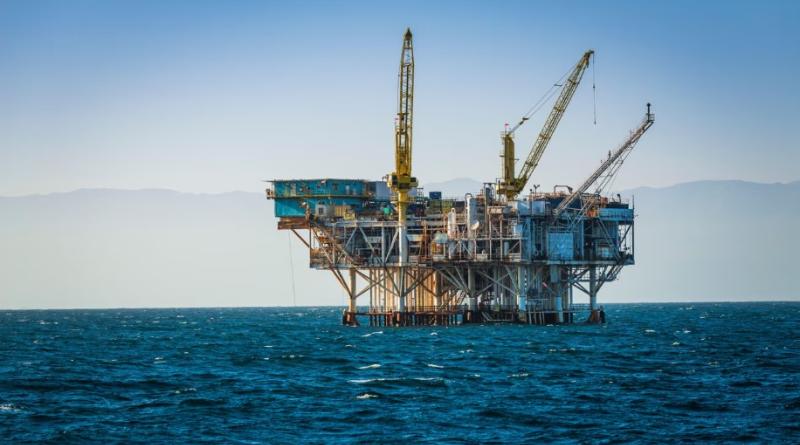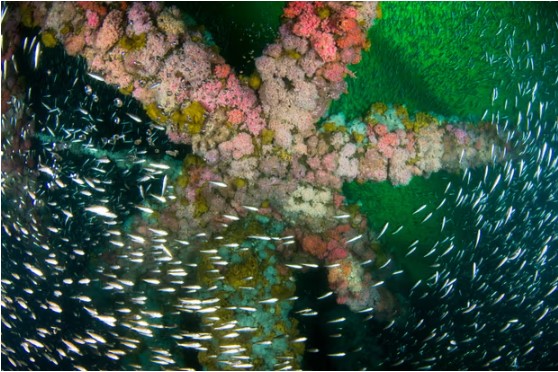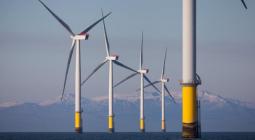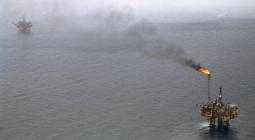‘Every square inch is covered in life’: the ageing oil rigs that became marine oases

Built decades ago, California’s offshore oil platforms are home to a huge diversity of marine life. Now a debate rages over their future
On a recent August afternoon, Ann Scarborough Bull motored out two miles from the coast of Santa Barbara onboard a research vessel called the Danny C. The marine biologist and her colleagues had an unusual destination in their sights: a disused oil platform that loomed ahead like a forgotten skyscraper reaching up from the horizon.
The team wasn’t interested in the platform itself, but what lurked beneath. When they reached the ageing structure, named Holly, they lowered a car-sized remote- controlled vehicle under the waves.
There, they saw hundreds of thousands of juvenile rockfish finding shelter amid the hulking metal structure, alongside waving white anemones, clusters of mussels, and silver jack mackerel.
The seasoned marine biologists have been observing this remarkable spectacle for years. Holly, which was put out of use in 2015, is one of 27 oil rigs built off the coast of California decades ago that have become hotbeds of biological activity.
While not natural structures, their platforms have been embedded into the muddy seabed long enough to become part of the ocean environment, providing a home for creatures like mussels and barnacles, which in turn attract larger fish and sea lions that find safety and food there.
After two and a half decades of studying the rigs, Bull says it’s clear to her: “These places are extremely productive, both for commercial and recreational fisheries and for invertebrates.”
Now, as California and the US shift away from offshore drilling and toward greener energy, a debate is mounting over their future. On one side are those who argue disused rigs are an environmental blight and should be removed entirely. On the other side are people, many of them scientists, who say we should embrace these accidental oases and that removing the structures is morally wrong. In other parts of the world, oil rigs have successfully become artificial reefs, in a policy known as rigs to reefs.
For Milton Love, a scientist at the University of California, Santa Barbara, who was on the boat with Bull, it’s a matter of ethics. He first encountered the rigs as an undergraduate student in the late 1960s when he was working as a commercial fisherman and collected fish off the rigs for a public aquarium, just as the platforms started to be installed. “There were a lot of fish,” he says. “That stuck in my mind.”

When he returned to the platforms as a professor years later, Love was initially surprised to find highly diverse communities of fish at each rig. Sites closer to shore had more surfperch, while rigs further out had more ocean fish. He also started to feel uneasy about how the creatures were being discussed. “It kind of crept up on me at some point that removing these things is immoral.”
The fish don’t know they are complicit in a fossil fuel infrastructure that is causing a climate crisis – they just see a hard structure and invertebrates attached to it, and a place to hide.
Bull agrees. “If you take away habitat, then there’s no going back,”she says. “You would never allow the willful destruction of a kelp bed, or of a rocky reef, even though rigs have similar biodiversity.”
An ecosystem emerges
Life tends to find a way, as they say – especially in the ocean.
Drop a tire off a boat on the coast, Love says, and within a month there will be a species like the brown rockfish living in it, darting in and out of the rubber.
The same is true of the rigs. California’s oil rigs were built between 1967 and 1989, and many are now nearing the end of their fossil fuel lives – of the 27 that were built, only 15 are still pumping.
Once the metal structures were installed in the sea bed, they were probably populated quickly by tiny plankton floating around in search of something to hold on to. Then a succession of creatures joined them: barnacles first, which got crowded out by mussels. Within months, fish were living in the rig structures – the lattice metal is an ideal structure to hide in, better than sand, where they are completely exposed to predation.
Within a year or two, an entire ecosystem sprung up. “Nature does abhor a vacuum,” Love says, “which is the reason that on a platform, every square inch is covered in life.”
Two decades after first encountering the rigs, Love was back at UC Santa Barbara working as a marine biologist, and he realized there was almost no scientific research on oil rigs and fish abundance.
What he and Bull discovered – both in terms of the variety of sea life and how the rigs are used by animals – has been astounding. Love, Bull and other colleagues have dived, used submarines and remotely operated vehicles to study what lives there, and they estimate there are probably billions of creatures – from barnacles to mammals – that rely on the rigs for habitat.

According to a 2014 study they co-authored, the rigs were some of the most “productive” ocean habitats in the world, a term that refers to biomass – or number of fish and other creatures and how much space they take up – per unit area. The research showed the rigs to be about 27 times more productive than the natural rocky reefs in California.
Jeremy Claisse, a professor at Cal Poly Pomona who co-authored the study with Love and Bull, said: “In college and grad school, you always read about how productive coral reef ecosystems and these estuary ecosystems are, and to do the math and find out these are as productive for fishes as those systems – that was pretty surprising.”
Subsequent studies showed that some species of rockfish produce 10 to 100 times more eggs and larvae at these platforms than at natural reefs. That’s partly because many big adult fish are being caught by fishers at natural rocky reefs, but less so at rigs, where they have more protection.
In some cases, the platforms are actually important to the populations of fish as a whole. In 2000, Love found that in the slow-growing rockfish bocaccio, a commercially important but overfished species, the rigs were home to one-fifth of the average number of juvenile fish that survive each year. Another study Love co-authored in 2012 tagged lingcod and rockfish and moved them to similar habitat on a natural reef across the Santa Barbara Channel to a protected area of Anacapa Island. Of the fish that were relocated, 25% of them swam back to their homes at the rig, travelling more than seven miles. Some returned in just 10 hours.
Should they stay or should they go?
California was home to the first offshore oil platform in the US, built in 1896 on a pier in the very same waters off Santa Barbara county where the rigs’ future is disputed.
The debate over what comes next for these vestiges of the oil industry is not unique to the state. Other parts of the world have successfully removed rigs completely – or turned them into artificial reefs. In the Gulf of Mexico, where the rigs sit in much shallower waters, at least 573 platforms have been declared artificial reefs by the government. Some of them have even been incorporated into national marine sanctuaries.
The same could be done here, although the technical and legal landscape is trickier. The rigs are submerged in 800 to 1,000ft of water – a depth that has never been decommissioned before – and would require explosives to dislodge them from the seabed, then huge cranes and cargo ships to remove them. It’s costly in terms of carbon footprint but also in dollars: the most recent estimate for removing all platforms off of the California coast totals $8bn, according to Bull.
In 2010, the then governor, Arnold Schwarzenegger, began allowing oil companies to turn their platforms into artificial reefs, then donate the cost saved by not having to remove the rigs entirely to a state conservation fund.

For Emily Hazelwood, a marine conservation biologist and offshore energy consultant who consults on rigs to reefs projects, the idea is win-win-win: “The state wins by getting an endowment, the environment wins because the reefs get to stay, and the oil and gas companies also win by saving money.”
But environmental groups don’t see a win. They cite the visual pollution of rigs on the ocean horizon and say that the plan lets fossil fuel companies escape paying for the end of life of their dirty products. Some called the plan “rigs to grief”. Linda Krop, chief counsel of the non-profit Environmental Defense Center, says her group has been involved in the issue of rigs since 1996, when Chevron was required to remove four platforms. The company did, but it left behind piles of junk on the ocean floor in the form of 20ft-tall toxic debris mounds.
Krop says her group’s preference would be to have “as clean an environment at sea as possible”, adding that full removal would allow the ecosystem to return to its original function.
The researchers say tests at the site show the fishes there don’t have levels of heavy metals different from fish living away from the platforms in the vicinity, and that the companies are required to seal the wells after their lifespan is complete.
For Love, it simply feels wrong to remove something that’s home to millions of creatures. “It just pisses me off, the hypocrisy of environmental groups who say: yeah, we’re all for biodiversity, except on artificial stuff, and then they can all die,” he says. “It drives me insane.”
He draws the analogy with a mine whose resources have been tapped, and a mining company that wants to close it down, but rabbits and birds and deer have moved in. Do we blow up the mine and kill those animals, or let it remain in some modified form? “Well, in our little story, people would freak out,” he says. “They’d say: we don’t want you to kill Bambi. But so what’s the difference between killing Bambi and killing sea anemones?”
Hazelwood says she wants the public to look at the structures as more than what you see from a beach chair – “not just menacing industrial giants, but vibrant ecosystems that exist below the surface”.
Photograph: Russ Bishop/Alamy - Some platforms off Santa Barbara, California, are teeming with marine life.






